Assessment 3: System Analysis and Design Report on Cloud Solutions
VerifiedAdded on 2020/03/15
|13
|2777
|157
Report
AI Summary
This report delves into the application of cloud-based solutions within the framework of system analysis and design. It begins by introducing cloud technology, emphasizing its role in virtualizing IT resources and its evolution over time. The report outlines non-functional requirements, such as system qualities, user interfaces, and system constraints, which influence the design and performance of cloud-based systems. It then explores cloud-based solutions, detailing their strengths, including resource flexibility and cost reduction, and weaknesses, such as security and internet dependency. The discussion extends to data handling and security, emphasizing encryption, authentication, and user sensitization. Furthermore, the report examines the System Development Life Cycle (SDLC) approach, contrasting predictive and adaptive methods, and recommends an adaptive approach for the Headspace project, highlighting the importance of flexibility and scalability. The conclusion summarizes the benefits and drawbacks of cloud solutions, advocating for their implementation while acknowledging the need for robust security measures. The report aims to provide students with a comprehensive understanding of cloud technology and its integration into system analysis and design.

Running Head: SYSTEM ANALYSIS AND DESIGN
Assessment 3
[Student Name Here]
[Institution’s Name Here]
[Professor’s Name Here]
[Date Here]
Assessment 3
[Student Name Here]
[Institution’s Name Here]
[Professor’s Name Here]
[Date Here]
Paraphrase This Document
Need a fresh take? Get an instant paraphrase of this document with our AI Paraphraser

SYSTEM ANALYSIS AND DESIGN 2
Table of Contents
Introduction....................................................................................................................................3
Non-functional requirements........................................................................................................3
System qualities...........................................................................................................................4
System interface...........................................................................................................................4
User interface...............................................................................................................................4
System constraints........................................................................................................................5
Cloud-based solutions....................................................................................................................5
Cloud solutions strengths.............................................................................................................6
Weaknesses..................................................................................................................................6
Handling and securing the data....................................................................................................6
SDLC (system development life cycle) approach and methods.................................................7
Predictive approach......................................................................................................................7
Pros of the approach.................................................................................................................7
Cons of the method...................................................................................................................8
Adaptive SDLC method...........................................................................................................8
Advantages of the approach.....................................................................................................8
Disadvantages...........................................................................................................................9
Headspace recommendation.........................................................................................................9
Conclusion......................................................................................................................................9
References.....................................................................................................................................11
Table of Contents
Introduction....................................................................................................................................3
Non-functional requirements........................................................................................................3
System qualities...........................................................................................................................4
System interface...........................................................................................................................4
User interface...............................................................................................................................4
System constraints........................................................................................................................5
Cloud-based solutions....................................................................................................................5
Cloud solutions strengths.............................................................................................................6
Weaknesses..................................................................................................................................6
Handling and securing the data....................................................................................................6
SDLC (system development life cycle) approach and methods.................................................7
Predictive approach......................................................................................................................7
Pros of the approach.................................................................................................................7
Cons of the method...................................................................................................................8
Adaptive SDLC method...........................................................................................................8
Advantages of the approach.....................................................................................................8
Disadvantages...........................................................................................................................9
Headspace recommendation.........................................................................................................9
Conclusion......................................................................................................................................9
References.....................................................................................................................................11
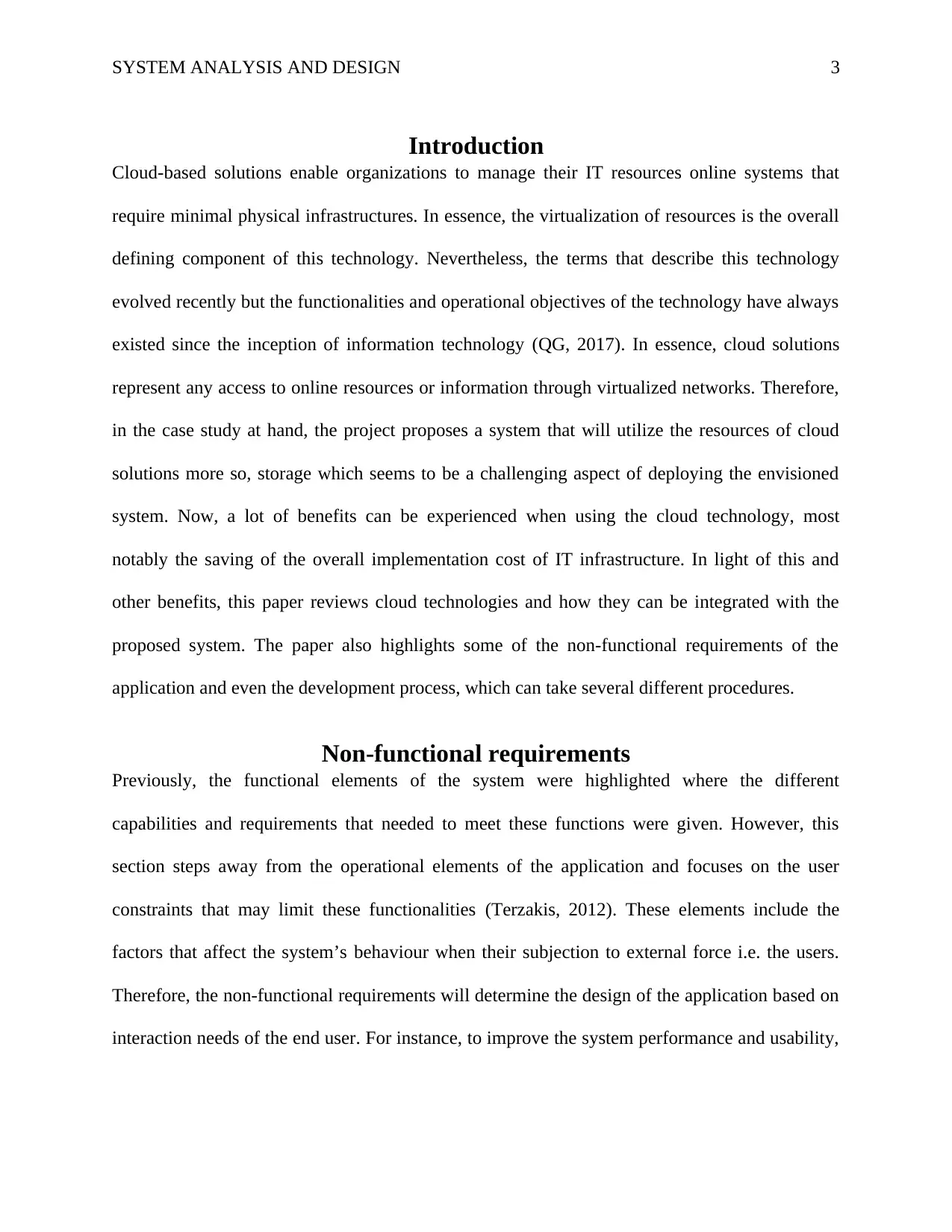
SYSTEM ANALYSIS AND DESIGN 3
Introduction
Cloud-based solutions enable organizations to manage their IT resources online systems that
require minimal physical infrastructures. In essence, the virtualization of resources is the overall
defining component of this technology. Nevertheless, the terms that describe this technology
evolved recently but the functionalities and operational objectives of the technology have always
existed since the inception of information technology (QG, 2017). In essence, cloud solutions
represent any access to online resources or information through virtualized networks. Therefore,
in the case study at hand, the project proposes a system that will utilize the resources of cloud
solutions more so, storage which seems to be a challenging aspect of deploying the envisioned
system. Now, a lot of benefits can be experienced when using the cloud technology, most
notably the saving of the overall implementation cost of IT infrastructure. In light of this and
other benefits, this paper reviews cloud technologies and how they can be integrated with the
proposed system. The paper also highlights some of the non-functional requirements of the
application and even the development process, which can take several different procedures.
Non-functional requirements
Previously, the functional elements of the system were highlighted where the different
capabilities and requirements that needed to meet these functions were given. However, this
section steps away from the operational elements of the application and focuses on the user
constraints that may limit these functionalities (Terzakis, 2012). These elements include the
factors that affect the system’s behaviour when their subjection to external force i.e. the users.
Therefore, the non-functional requirements will determine the design of the application based on
interaction needs of the end user. For instance, to improve the system performance and usability,
Introduction
Cloud-based solutions enable organizations to manage their IT resources online systems that
require minimal physical infrastructures. In essence, the virtualization of resources is the overall
defining component of this technology. Nevertheless, the terms that describe this technology
evolved recently but the functionalities and operational objectives of the technology have always
existed since the inception of information technology (QG, 2017). In essence, cloud solutions
represent any access to online resources or information through virtualized networks. Therefore,
in the case study at hand, the project proposes a system that will utilize the resources of cloud
solutions more so, storage which seems to be a challenging aspect of deploying the envisioned
system. Now, a lot of benefits can be experienced when using the cloud technology, most
notably the saving of the overall implementation cost of IT infrastructure. In light of this and
other benefits, this paper reviews cloud technologies and how they can be integrated with the
proposed system. The paper also highlights some of the non-functional requirements of the
application and even the development process, which can take several different procedures.
Non-functional requirements
Previously, the functional elements of the system were highlighted where the different
capabilities and requirements that needed to meet these functions were given. However, this
section steps away from the operational elements of the application and focuses on the user
constraints that may limit these functionalities (Terzakis, 2012). These elements include the
factors that affect the system’s behaviour when their subjection to external force i.e. the users.
Therefore, the non-functional requirements will determine the design of the application based on
interaction needs of the end user. For instance, to improve the system performance and usability,
⊘ This is a preview!⊘
Do you want full access?
Subscribe today to unlock all pages.

Trusted by 1+ million students worldwide
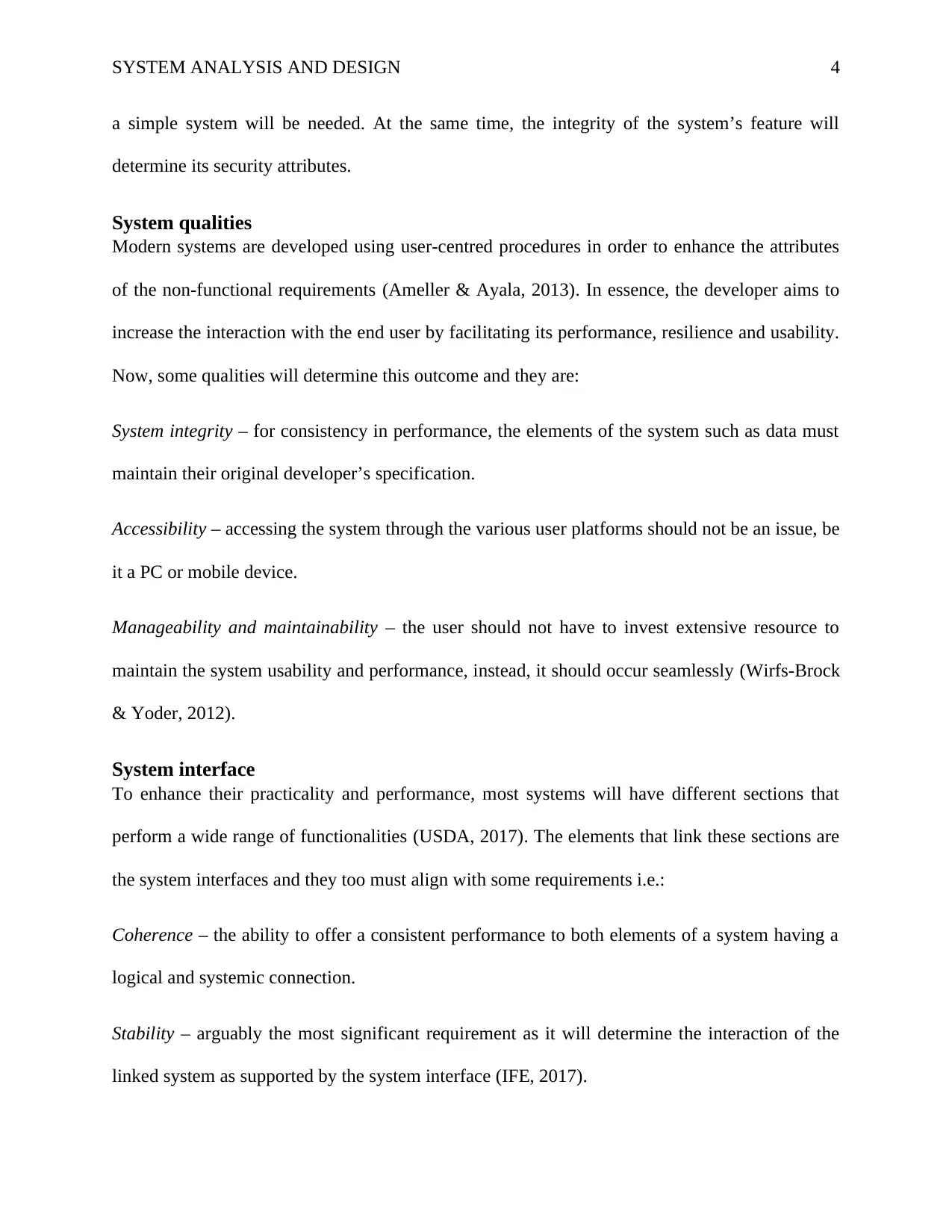
SYSTEM ANALYSIS AND DESIGN 4
a simple system will be needed. At the same time, the integrity of the system’s feature will
determine its security attributes.
System qualities
Modern systems are developed using user-centred procedures in order to enhance the attributes
of the non-functional requirements (Ameller & Ayala, 2013). In essence, the developer aims to
increase the interaction with the end user by facilitating its performance, resilience and usability.
Now, some qualities will determine this outcome and they are:
System integrity – for consistency in performance, the elements of the system such as data must
maintain their original developer’s specification.
Accessibility – accessing the system through the various user platforms should not be an issue, be
it a PC or mobile device.
Manageability and maintainability – the user should not have to invest extensive resource to
maintain the system usability and performance, instead, it should occur seamlessly (Wirfs-Brock
& Yoder, 2012).
System interface
To enhance their practicality and performance, most systems will have different sections that
perform a wide range of functionalities (USDA, 2017). The elements that link these sections are
the system interfaces and they too must align with some requirements i.e.:
Coherence – the ability to offer a consistent performance to both elements of a system having a
logical and systemic connection.
Stability – arguably the most significant requirement as it will determine the interaction of the
linked system as supported by the system interface (IFE, 2017).
a simple system will be needed. At the same time, the integrity of the system’s feature will
determine its security attributes.
System qualities
Modern systems are developed using user-centred procedures in order to enhance the attributes
of the non-functional requirements (Ameller & Ayala, 2013). In essence, the developer aims to
increase the interaction with the end user by facilitating its performance, resilience and usability.
Now, some qualities will determine this outcome and they are:
System integrity – for consistency in performance, the elements of the system such as data must
maintain their original developer’s specification.
Accessibility – accessing the system through the various user platforms should not be an issue, be
it a PC or mobile device.
Manageability and maintainability – the user should not have to invest extensive resource to
maintain the system usability and performance, instead, it should occur seamlessly (Wirfs-Brock
& Yoder, 2012).
System interface
To enhance their practicality and performance, most systems will have different sections that
perform a wide range of functionalities (USDA, 2017). The elements that link these sections are
the system interfaces and they too must align with some requirements i.e.:
Coherence – the ability to offer a consistent performance to both elements of a system having a
logical and systemic connection.
Stability – arguably the most significant requirement as it will determine the interaction of the
linked system as supported by the system interface (IFE, 2017).
Paraphrase This Document
Need a fresh take? Get an instant paraphrase of this document with our AI Paraphraser
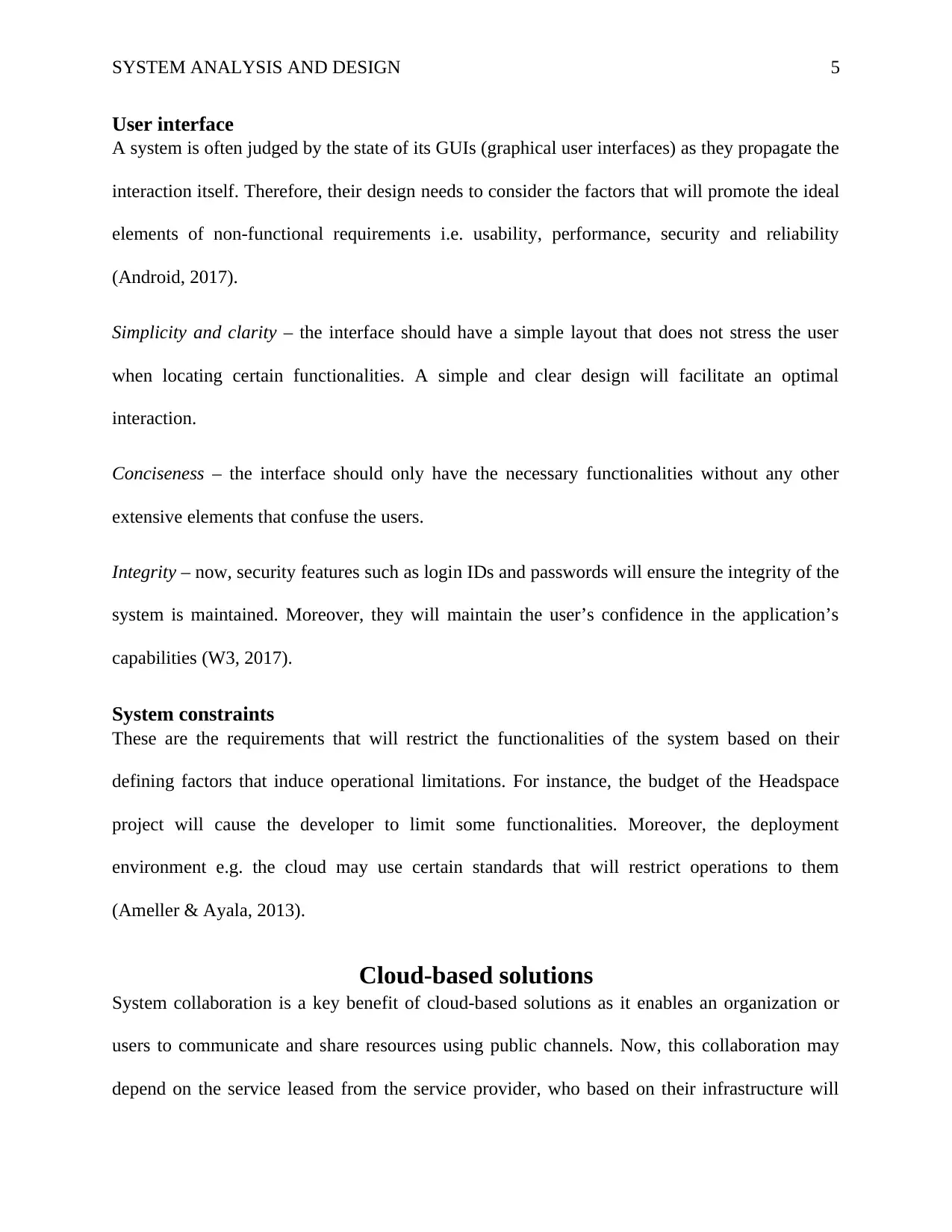
SYSTEM ANALYSIS AND DESIGN 5
User interface
A system is often judged by the state of its GUIs (graphical user interfaces) as they propagate the
interaction itself. Therefore, their design needs to consider the factors that will promote the ideal
elements of non-functional requirements i.e. usability, performance, security and reliability
(Android, 2017).
Simplicity and clarity – the interface should have a simple layout that does not stress the user
when locating certain functionalities. A simple and clear design will facilitate an optimal
interaction.
Conciseness – the interface should only have the necessary functionalities without any other
extensive elements that confuse the users.
Integrity – now, security features such as login IDs and passwords will ensure the integrity of the
system is maintained. Moreover, they will maintain the user’s confidence in the application’s
capabilities (W3, 2017).
System constraints
These are the requirements that will restrict the functionalities of the system based on their
defining factors that induce operational limitations. For instance, the budget of the Headspace
project will cause the developer to limit some functionalities. Moreover, the deployment
environment e.g. the cloud may use certain standards that will restrict operations to them
(Ameller & Ayala, 2013).
Cloud-based solutions
System collaboration is a key benefit of cloud-based solutions as it enables an organization or
users to communicate and share resources using public channels. Now, this collaboration may
depend on the service leased from the service provider, who based on their infrastructure will
User interface
A system is often judged by the state of its GUIs (graphical user interfaces) as they propagate the
interaction itself. Therefore, their design needs to consider the factors that will promote the ideal
elements of non-functional requirements i.e. usability, performance, security and reliability
(Android, 2017).
Simplicity and clarity – the interface should have a simple layout that does not stress the user
when locating certain functionalities. A simple and clear design will facilitate an optimal
interaction.
Conciseness – the interface should only have the necessary functionalities without any other
extensive elements that confuse the users.
Integrity – now, security features such as login IDs and passwords will ensure the integrity of the
system is maintained. Moreover, they will maintain the user’s confidence in the application’s
capabilities (W3, 2017).
System constraints
These are the requirements that will restrict the functionalities of the system based on their
defining factors that induce operational limitations. For instance, the budget of the Headspace
project will cause the developer to limit some functionalities. Moreover, the deployment
environment e.g. the cloud may use certain standards that will restrict operations to them
(Ameller & Ayala, 2013).
Cloud-based solutions
System collaboration is a key benefit of cloud-based solutions as it enables an organization or
users to communicate and share resources using public channels. Now, this collaboration may
depend on the service leased from the service provider, who based on their infrastructure will
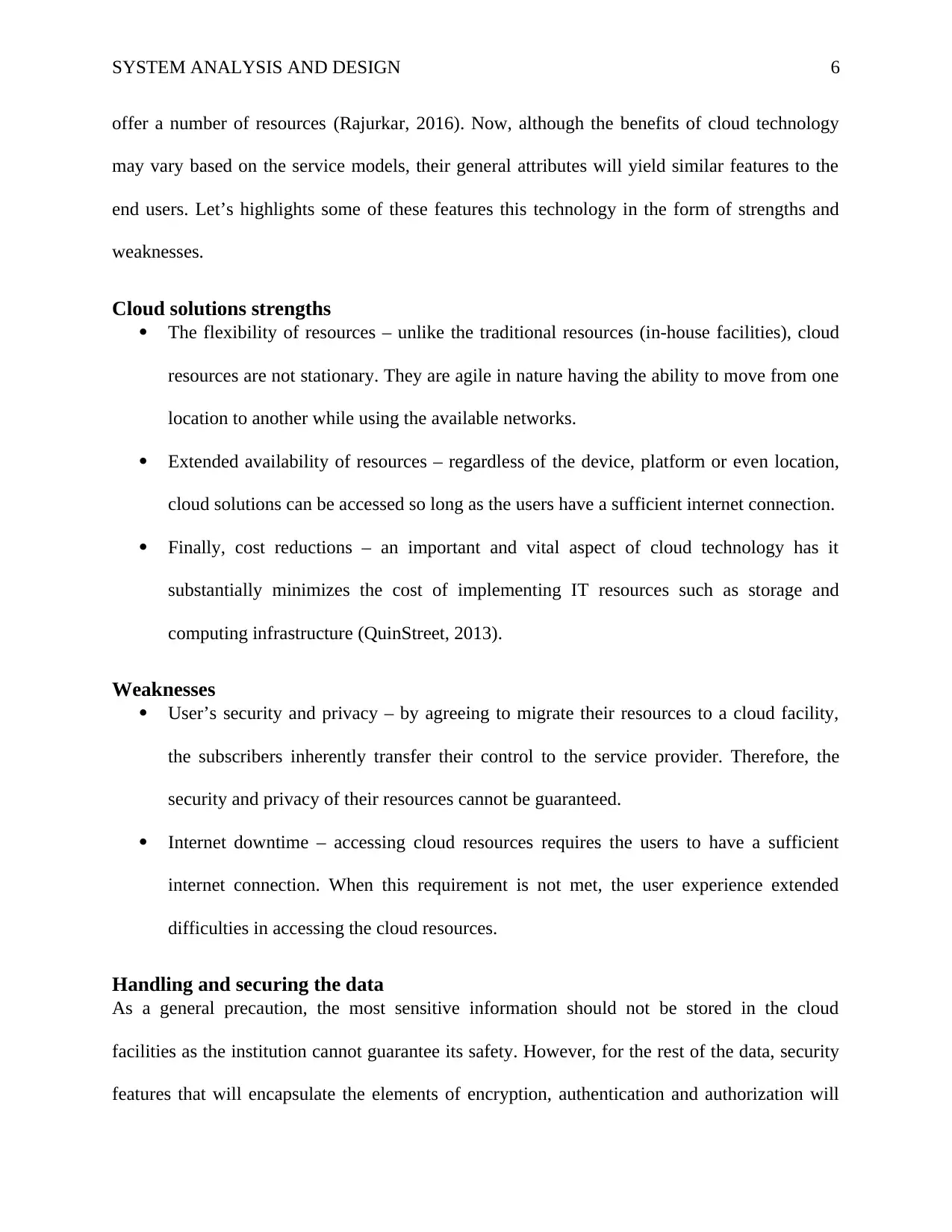
SYSTEM ANALYSIS AND DESIGN 6
offer a number of resources (Rajurkar, 2016). Now, although the benefits of cloud technology
may vary based on the service models, their general attributes will yield similar features to the
end users. Let’s highlights some of these features this technology in the form of strengths and
weaknesses.
Cloud solutions strengths
The flexibility of resources – unlike the traditional resources (in-house facilities), cloud
resources are not stationary. They are agile in nature having the ability to move from one
location to another while using the available networks.
Extended availability of resources – regardless of the device, platform or even location,
cloud solutions can be accessed so long as the users have a sufficient internet connection.
Finally, cost reductions – an important and vital aspect of cloud technology has it
substantially minimizes the cost of implementing IT resources such as storage and
computing infrastructure (QuinStreet, 2013).
Weaknesses
User’s security and privacy – by agreeing to migrate their resources to a cloud facility,
the subscribers inherently transfer their control to the service provider. Therefore, the
security and privacy of their resources cannot be guaranteed.
Internet downtime – accessing cloud resources requires the users to have a sufficient
internet connection. When this requirement is not met, the user experience extended
difficulties in accessing the cloud resources.
Handling and securing the data
As a general precaution, the most sensitive information should not be stored in the cloud
facilities as the institution cannot guarantee its safety. However, for the rest of the data, security
features that will encapsulate the elements of encryption, authentication and authorization will
offer a number of resources (Rajurkar, 2016). Now, although the benefits of cloud technology
may vary based on the service models, their general attributes will yield similar features to the
end users. Let’s highlights some of these features this technology in the form of strengths and
weaknesses.
Cloud solutions strengths
The flexibility of resources – unlike the traditional resources (in-house facilities), cloud
resources are not stationary. They are agile in nature having the ability to move from one
location to another while using the available networks.
Extended availability of resources – regardless of the device, platform or even location,
cloud solutions can be accessed so long as the users have a sufficient internet connection.
Finally, cost reductions – an important and vital aspect of cloud technology has it
substantially minimizes the cost of implementing IT resources such as storage and
computing infrastructure (QuinStreet, 2013).
Weaknesses
User’s security and privacy – by agreeing to migrate their resources to a cloud facility,
the subscribers inherently transfer their control to the service provider. Therefore, the
security and privacy of their resources cannot be guaranteed.
Internet downtime – accessing cloud resources requires the users to have a sufficient
internet connection. When this requirement is not met, the user experience extended
difficulties in accessing the cloud resources.
Handling and securing the data
As a general precaution, the most sensitive information should not be stored in the cloud
facilities as the institution cannot guarantee its safety. However, for the rest of the data, security
features that will encapsulate the elements of encryption, authentication and authorization will
⊘ This is a preview!⊘
Do you want full access?
Subscribe today to unlock all pages.

Trusted by 1+ million students worldwide
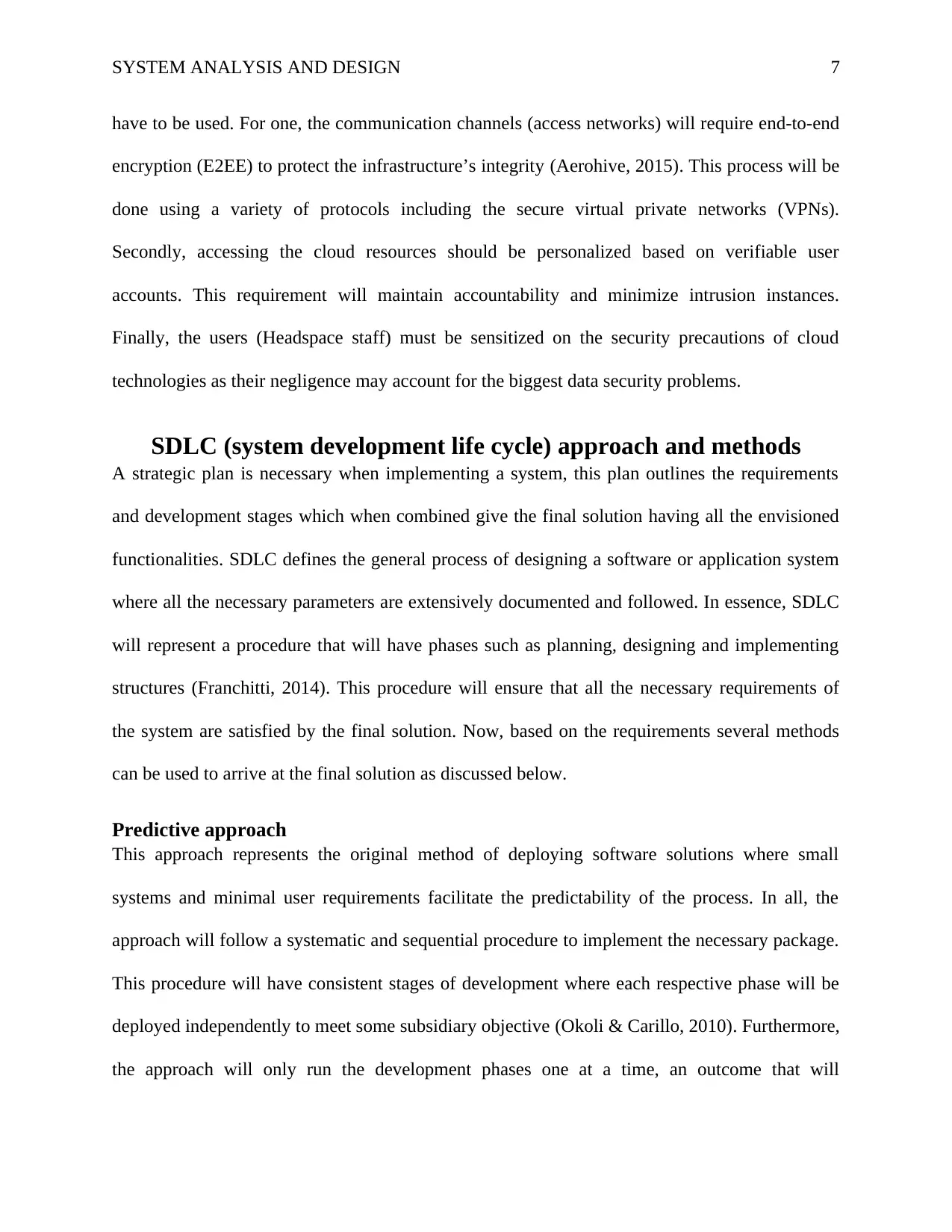
SYSTEM ANALYSIS AND DESIGN 7
have to be used. For one, the communication channels (access networks) will require end-to-end
encryption (E2EE) to protect the infrastructure’s integrity (Aerohive, 2015). This process will be
done using a variety of protocols including the secure virtual private networks (VPNs).
Secondly, accessing the cloud resources should be personalized based on verifiable user
accounts. This requirement will maintain accountability and minimize intrusion instances.
Finally, the users (Headspace staff) must be sensitized on the security precautions of cloud
technologies as their negligence may account for the biggest data security problems.
SDLC (system development life cycle) approach and methods
A strategic plan is necessary when implementing a system, this plan outlines the requirements
and development stages which when combined give the final solution having all the envisioned
functionalities. SDLC defines the general process of designing a software or application system
where all the necessary parameters are extensively documented and followed. In essence, SDLC
will represent a procedure that will have phases such as planning, designing and implementing
structures (Franchitti, 2014). This procedure will ensure that all the necessary requirements of
the system are satisfied by the final solution. Now, based on the requirements several methods
can be used to arrive at the final solution as discussed below.
Predictive approach
This approach represents the original method of deploying software solutions where small
systems and minimal user requirements facilitate the predictability of the process. In all, the
approach will follow a systematic and sequential procedure to implement the necessary package.
This procedure will have consistent stages of development where each respective phase will be
deployed independently to meet some subsidiary objective (Okoli & Carillo, 2010). Furthermore,
the approach will only run the development phases one at a time, an outcome that will
have to be used. For one, the communication channels (access networks) will require end-to-end
encryption (E2EE) to protect the infrastructure’s integrity (Aerohive, 2015). This process will be
done using a variety of protocols including the secure virtual private networks (VPNs).
Secondly, accessing the cloud resources should be personalized based on verifiable user
accounts. This requirement will maintain accountability and minimize intrusion instances.
Finally, the users (Headspace staff) must be sensitized on the security precautions of cloud
technologies as their negligence may account for the biggest data security problems.
SDLC (system development life cycle) approach and methods
A strategic plan is necessary when implementing a system, this plan outlines the requirements
and development stages which when combined give the final solution having all the envisioned
functionalities. SDLC defines the general process of designing a software or application system
where all the necessary parameters are extensively documented and followed. In essence, SDLC
will represent a procedure that will have phases such as planning, designing and implementing
structures (Franchitti, 2014). This procedure will ensure that all the necessary requirements of
the system are satisfied by the final solution. Now, based on the requirements several methods
can be used to arrive at the final solution as discussed below.
Predictive approach
This approach represents the original method of deploying software solutions where small
systems and minimal user requirements facilitate the predictability of the process. In all, the
approach will follow a systematic and sequential procedure to implement the necessary package.
This procedure will have consistent stages of development where each respective phase will be
deployed independently to meet some subsidiary objective (Okoli & Carillo, 2010). Furthermore,
the approach will only run the development phases one at a time, an outcome that will
Paraphrase This Document
Need a fresh take? Get an instant paraphrase of this document with our AI Paraphraser
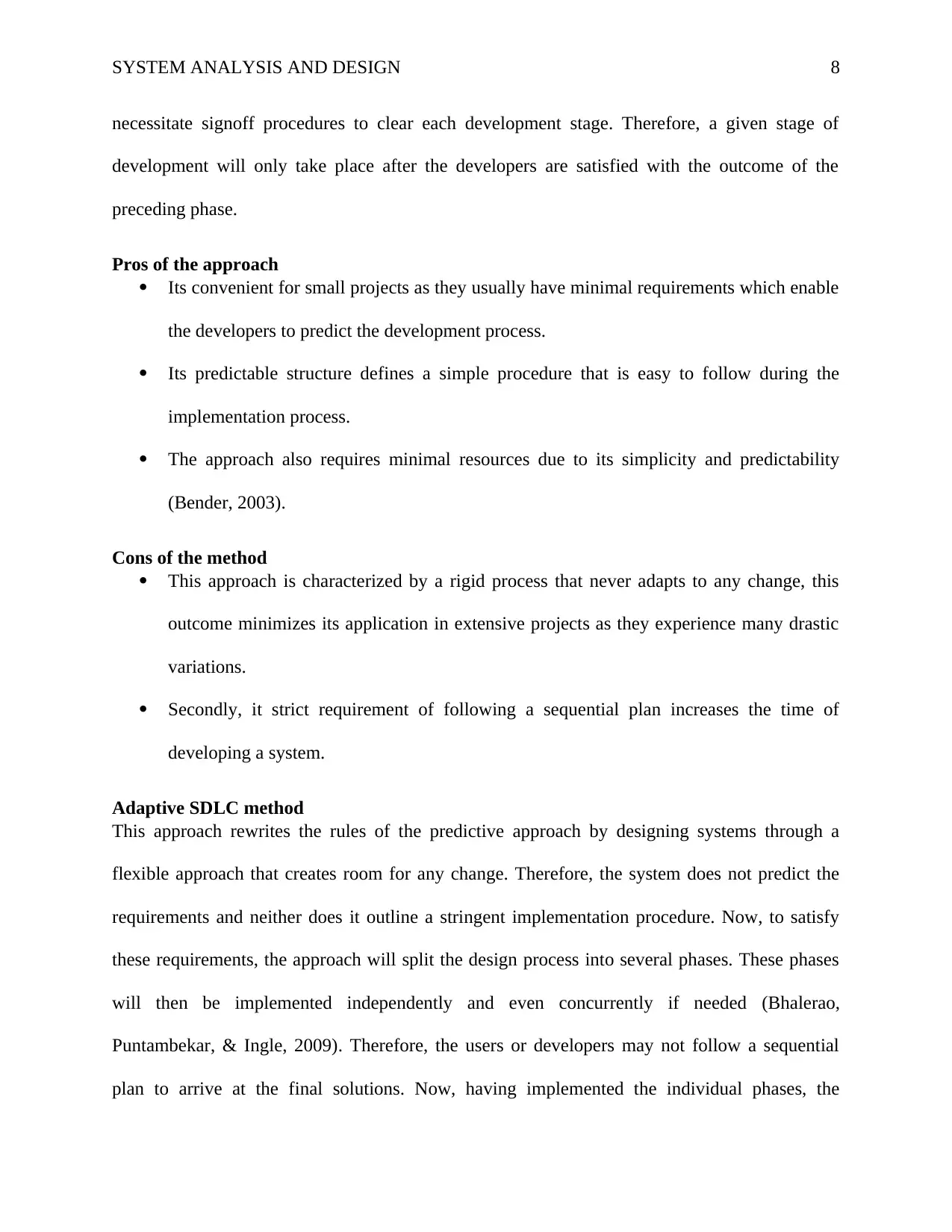
SYSTEM ANALYSIS AND DESIGN 8
necessitate signoff procedures to clear each development stage. Therefore, a given stage of
development will only take place after the developers are satisfied with the outcome of the
preceding phase.
Pros of the approach
Its convenient for small projects as they usually have minimal requirements which enable
the developers to predict the development process.
Its predictable structure defines a simple procedure that is easy to follow during the
implementation process.
The approach also requires minimal resources due to its simplicity and predictability
(Bender, 2003).
Cons of the method
This approach is characterized by a rigid process that never adapts to any change, this
outcome minimizes its application in extensive projects as they experience many drastic
variations.
Secondly, it strict requirement of following a sequential plan increases the time of
developing a system.
Adaptive SDLC method
This approach rewrites the rules of the predictive approach by designing systems through a
flexible approach that creates room for any change. Therefore, the system does not predict the
requirements and neither does it outline a stringent implementation procedure. Now, to satisfy
these requirements, the approach will split the design process into several phases. These phases
will then be implemented independently and even concurrently if needed (Bhalerao,
Puntambekar, & Ingle, 2009). Therefore, the users or developers may not follow a sequential
plan to arrive at the final solutions. Now, having implemented the individual phases, the
necessitate signoff procedures to clear each development stage. Therefore, a given stage of
development will only take place after the developers are satisfied with the outcome of the
preceding phase.
Pros of the approach
Its convenient for small projects as they usually have minimal requirements which enable
the developers to predict the development process.
Its predictable structure defines a simple procedure that is easy to follow during the
implementation process.
The approach also requires minimal resources due to its simplicity and predictability
(Bender, 2003).
Cons of the method
This approach is characterized by a rigid process that never adapts to any change, this
outcome minimizes its application in extensive projects as they experience many drastic
variations.
Secondly, it strict requirement of following a sequential plan increases the time of
developing a system.
Adaptive SDLC method
This approach rewrites the rules of the predictive approach by designing systems through a
flexible approach that creates room for any change. Therefore, the system does not predict the
requirements and neither does it outline a stringent implementation procedure. Now, to satisfy
these requirements, the approach will split the design process into several phases. These phases
will then be implemented independently and even concurrently if needed (Bhalerao,
Puntambekar, & Ingle, 2009). Therefore, the users or developers may not follow a sequential
plan to arrive at the final solutions. Now, having implemented the individual phases, the
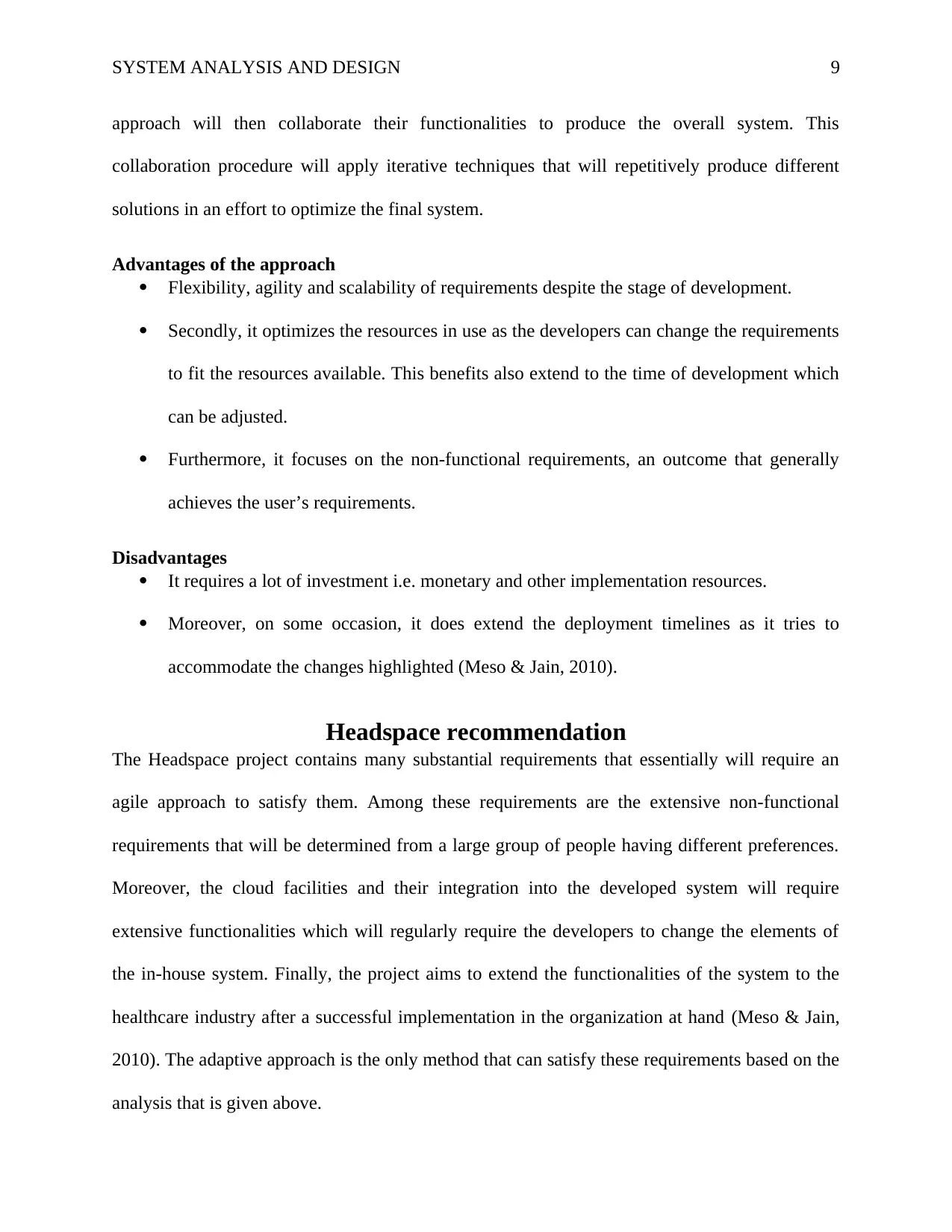
SYSTEM ANALYSIS AND DESIGN 9
approach will then collaborate their functionalities to produce the overall system. This
collaboration procedure will apply iterative techniques that will repetitively produce different
solutions in an effort to optimize the final system.
Advantages of the approach
Flexibility, agility and scalability of requirements despite the stage of development.
Secondly, it optimizes the resources in use as the developers can change the requirements
to fit the resources available. This benefits also extend to the time of development which
can be adjusted.
Furthermore, it focuses on the non-functional requirements, an outcome that generally
achieves the user’s requirements.
Disadvantages
It requires a lot of investment i.e. monetary and other implementation resources.
Moreover, on some occasion, it does extend the deployment timelines as it tries to
accommodate the changes highlighted (Meso & Jain, 2010).
Headspace recommendation
The Headspace project contains many substantial requirements that essentially will require an
agile approach to satisfy them. Among these requirements are the extensive non-functional
requirements that will be determined from a large group of people having different preferences.
Moreover, the cloud facilities and their integration into the developed system will require
extensive functionalities which will regularly require the developers to change the elements of
the in-house system. Finally, the project aims to extend the functionalities of the system to the
healthcare industry after a successful implementation in the organization at hand (Meso & Jain,
2010). The adaptive approach is the only method that can satisfy these requirements based on the
analysis that is given above.
approach will then collaborate their functionalities to produce the overall system. This
collaboration procedure will apply iterative techniques that will repetitively produce different
solutions in an effort to optimize the final system.
Advantages of the approach
Flexibility, agility and scalability of requirements despite the stage of development.
Secondly, it optimizes the resources in use as the developers can change the requirements
to fit the resources available. This benefits also extend to the time of development which
can be adjusted.
Furthermore, it focuses on the non-functional requirements, an outcome that generally
achieves the user’s requirements.
Disadvantages
It requires a lot of investment i.e. monetary and other implementation resources.
Moreover, on some occasion, it does extend the deployment timelines as it tries to
accommodate the changes highlighted (Meso & Jain, 2010).
Headspace recommendation
The Headspace project contains many substantial requirements that essentially will require an
agile approach to satisfy them. Among these requirements are the extensive non-functional
requirements that will be determined from a large group of people having different preferences.
Moreover, the cloud facilities and their integration into the developed system will require
extensive functionalities which will regularly require the developers to change the elements of
the in-house system. Finally, the project aims to extend the functionalities of the system to the
healthcare industry after a successful implementation in the organization at hand (Meso & Jain,
2010). The adaptive approach is the only method that can satisfy these requirements based on the
analysis that is given above.
⊘ This is a preview!⊘
Do you want full access?
Subscribe today to unlock all pages.

Trusted by 1+ million students worldwide
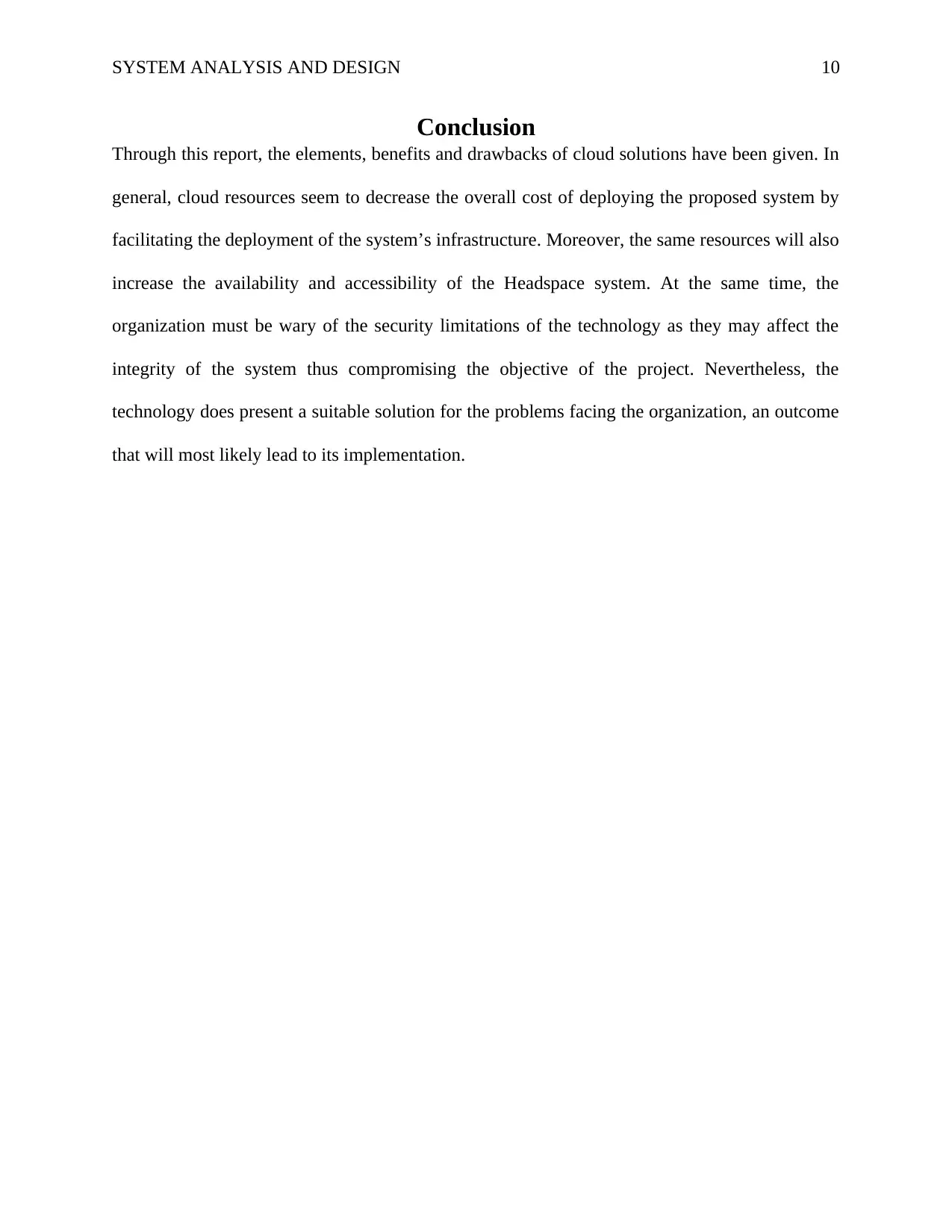
SYSTEM ANALYSIS AND DESIGN 10
Conclusion
Through this report, the elements, benefits and drawbacks of cloud solutions have been given. In
general, cloud resources seem to decrease the overall cost of deploying the proposed system by
facilitating the deployment of the system’s infrastructure. Moreover, the same resources will also
increase the availability and accessibility of the Headspace system. At the same time, the
organization must be wary of the security limitations of the technology as they may affect the
integrity of the system thus compromising the objective of the project. Nevertheless, the
technology does present a suitable solution for the problems facing the organization, an outcome
that will most likely lead to its implementation.
Conclusion
Through this report, the elements, benefits and drawbacks of cloud solutions have been given. In
general, cloud resources seem to decrease the overall cost of deploying the proposed system by
facilitating the deployment of the system’s infrastructure. Moreover, the same resources will also
increase the availability and accessibility of the Headspace system. At the same time, the
organization must be wary of the security limitations of the technology as they may affect the
integrity of the system thus compromising the objective of the project. Nevertheless, the
technology does present a suitable solution for the problems facing the organization, an outcome
that will most likely lead to its implementation.
Paraphrase This Document
Need a fresh take? Get an instant paraphrase of this document with our AI Paraphraser
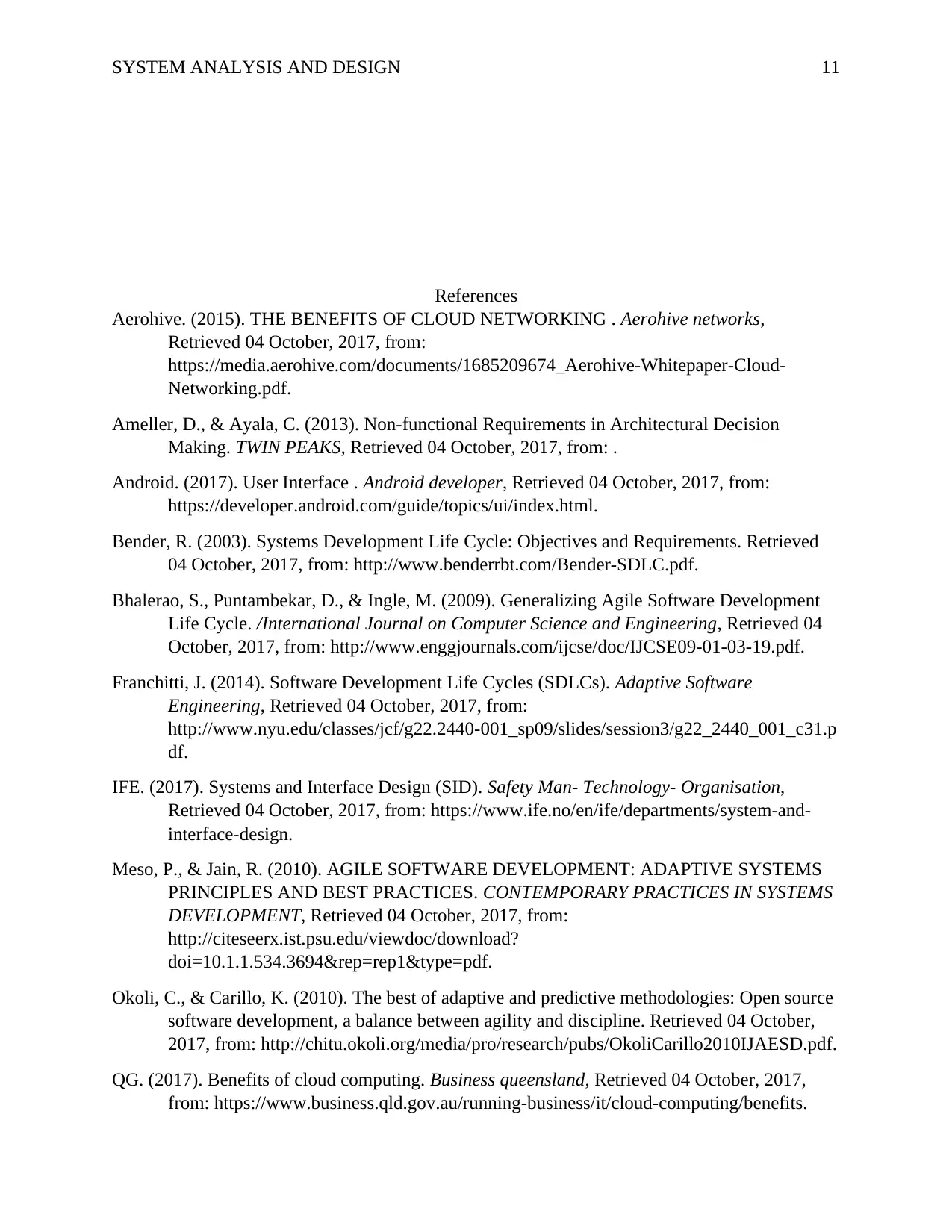
SYSTEM ANALYSIS AND DESIGN 11
References
Aerohive. (2015). THE BENEFITS OF CLOUD NETWORKING . Aerohive networks,
Retrieved 04 October, 2017, from:
https://media.aerohive.com/documents/1685209674_Aerohive-Whitepaper-Cloud-
Networking.pdf.
Ameller, D., & Ayala, C. (2013). Non-functional Requirements in Architectural Decision
Making. TWIN PEAKS, Retrieved 04 October, 2017, from: .
Android. (2017). User Interface . Android developer, Retrieved 04 October, 2017, from:
https://developer.android.com/guide/topics/ui/index.html.
Bender, R. (2003). Systems Development Life Cycle: Objectives and Requirements. Retrieved
04 October, 2017, from: http://www.benderrbt.com/Bender-SDLC.pdf.
Bhalerao, S., Puntambekar, D., & Ingle, M. (2009). Generalizing Agile Software Development
Life Cycle. /International Journal on Computer Science and Engineering, Retrieved 04
October, 2017, from: http://www.enggjournals.com/ijcse/doc/IJCSE09-01-03-19.pdf.
Franchitti, J. (2014). Software Development Life Cycles (SDLCs). Adaptive Software
Engineering, Retrieved 04 October, 2017, from:
http://www.nyu.edu/classes/jcf/g22.2440-001_sp09/slides/session3/g22_2440_001_c31.p
df.
IFE. (2017). Systems and Interface Design (SID). Safety Man- Technology- Organisation,
Retrieved 04 October, 2017, from: https://www.ife.no/en/ife/departments/system-and-
interface-design.
Meso, P., & Jain, R. (2010). AGILE SOFTWARE DEVELOPMENT: ADAPTIVE SYSTEMS
PRINCIPLES AND BEST PRACTICES. CONTEMPORARY PRACTICES IN SYSTEMS
DEVELOPMENT, Retrieved 04 October, 2017, from:
http://citeseerx.ist.psu.edu/viewdoc/download?
doi=10.1.1.534.3694&rep=rep1&type=pdf.
Okoli, C., & Carillo, K. (2010). The best of adaptive and predictive methodologies: Open source
software development, a balance between agility and discipline. Retrieved 04 October,
2017, from: http://chitu.okoli.org/media/pro/research/pubs/OkoliCarillo2010IJAESD.pdf.
QG. (2017). Benefits of cloud computing. Business queensland, Retrieved 04 October, 2017,
from: https://www.business.qld.gov.au/running-business/it/cloud-computing/benefits.
References
Aerohive. (2015). THE BENEFITS OF CLOUD NETWORKING . Aerohive networks,
Retrieved 04 October, 2017, from:
https://media.aerohive.com/documents/1685209674_Aerohive-Whitepaper-Cloud-
Networking.pdf.
Ameller, D., & Ayala, C. (2013). Non-functional Requirements in Architectural Decision
Making. TWIN PEAKS, Retrieved 04 October, 2017, from: .
Android. (2017). User Interface . Android developer, Retrieved 04 October, 2017, from:
https://developer.android.com/guide/topics/ui/index.html.
Bender, R. (2003). Systems Development Life Cycle: Objectives and Requirements. Retrieved
04 October, 2017, from: http://www.benderrbt.com/Bender-SDLC.pdf.
Bhalerao, S., Puntambekar, D., & Ingle, M. (2009). Generalizing Agile Software Development
Life Cycle. /International Journal on Computer Science and Engineering, Retrieved 04
October, 2017, from: http://www.enggjournals.com/ijcse/doc/IJCSE09-01-03-19.pdf.
Franchitti, J. (2014). Software Development Life Cycles (SDLCs). Adaptive Software
Engineering, Retrieved 04 October, 2017, from:
http://www.nyu.edu/classes/jcf/g22.2440-001_sp09/slides/session3/g22_2440_001_c31.p
df.
IFE. (2017). Systems and Interface Design (SID). Safety Man- Technology- Organisation,
Retrieved 04 October, 2017, from: https://www.ife.no/en/ife/departments/system-and-
interface-design.
Meso, P., & Jain, R. (2010). AGILE SOFTWARE DEVELOPMENT: ADAPTIVE SYSTEMS
PRINCIPLES AND BEST PRACTICES. CONTEMPORARY PRACTICES IN SYSTEMS
DEVELOPMENT, Retrieved 04 October, 2017, from:
http://citeseerx.ist.psu.edu/viewdoc/download?
doi=10.1.1.534.3694&rep=rep1&type=pdf.
Okoli, C., & Carillo, K. (2010). The best of adaptive and predictive methodologies: Open source
software development, a balance between agility and discipline. Retrieved 04 October,
2017, from: http://chitu.okoli.org/media/pro/research/pubs/OkoliCarillo2010IJAESD.pdf.
QG. (2017). Benefits of cloud computing. Business queensland, Retrieved 04 October, 2017,
from: https://www.business.qld.gov.au/running-business/it/cloud-computing/benefits.
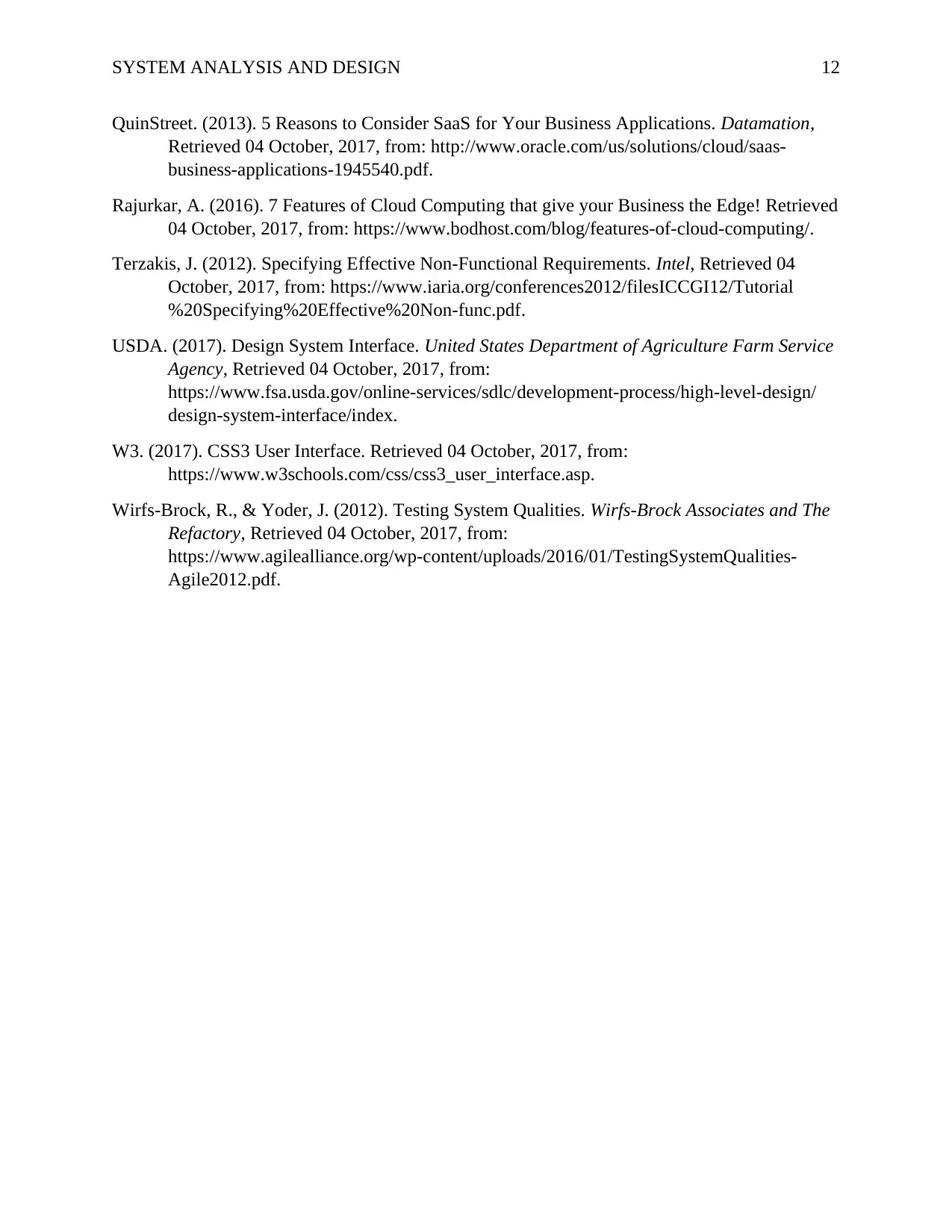
SYSTEM ANALYSIS AND DESIGN 12
QuinStreet. (2013). 5 Reasons to Consider SaaS for Your Business Applications. Datamation,
Retrieved 04 October, 2017, from: http://www.oracle.com/us/solutions/cloud/saas-
business-applications-1945540.pdf.
Rajurkar, A. (2016). 7 Features of Cloud Computing that give your Business the Edge! Retrieved
04 October, 2017, from: https://www.bodhost.com/blog/features-of-cloud-computing/.
Terzakis, J. (2012). Specifying Effective Non-Functional Requirements. Intel, Retrieved 04
October, 2017, from: https://www.iaria.org/conferences2012/filesICCGI12/Tutorial
%20Specifying%20Effective%20Non-func.pdf.
USDA. (2017). Design System Interface. United States Department of Agriculture Farm Service
Agency, Retrieved 04 October, 2017, from:
https://www.fsa.usda.gov/online-services/sdlc/development-process/high-level-design/
design-system-interface/index.
W3. (2017). CSS3 User Interface. Retrieved 04 October, 2017, from:
https://www.w3schools.com/css/css3_user_interface.asp.
Wirfs-Brock, R., & Yoder, J. (2012). Testing System Qualities. Wirfs-Brock Associates and The
Refactory, Retrieved 04 October, 2017, from:
https://www.agilealliance.org/wp-content/uploads/2016/01/TestingSystemQualities-
Agile2012.pdf.
QuinStreet. (2013). 5 Reasons to Consider SaaS for Your Business Applications. Datamation,
Retrieved 04 October, 2017, from: http://www.oracle.com/us/solutions/cloud/saas-
business-applications-1945540.pdf.
Rajurkar, A. (2016). 7 Features of Cloud Computing that give your Business the Edge! Retrieved
04 October, 2017, from: https://www.bodhost.com/blog/features-of-cloud-computing/.
Terzakis, J. (2012). Specifying Effective Non-Functional Requirements. Intel, Retrieved 04
October, 2017, from: https://www.iaria.org/conferences2012/filesICCGI12/Tutorial
%20Specifying%20Effective%20Non-func.pdf.
USDA. (2017). Design System Interface. United States Department of Agriculture Farm Service
Agency, Retrieved 04 October, 2017, from:
https://www.fsa.usda.gov/online-services/sdlc/development-process/high-level-design/
design-system-interface/index.
W3. (2017). CSS3 User Interface. Retrieved 04 October, 2017, from:
https://www.w3schools.com/css/css3_user_interface.asp.
Wirfs-Brock, R., & Yoder, J. (2012). Testing System Qualities. Wirfs-Brock Associates and The
Refactory, Retrieved 04 October, 2017, from:
https://www.agilealliance.org/wp-content/uploads/2016/01/TestingSystemQualities-
Agile2012.pdf.
⊘ This is a preview!⊘
Do you want full access?
Subscribe today to unlock all pages.

Trusted by 1+ million students worldwide
1 out of 13
Related Documents
Your All-in-One AI-Powered Toolkit for Academic Success.
+13062052269
info@desklib.com
Available 24*7 on WhatsApp / Email
![[object Object]](/_next/static/media/star-bottom.7253800d.svg)
Unlock your academic potential
Copyright © 2020–2025 A2Z Services. All Rights Reserved. Developed and managed by ZUCOL.





